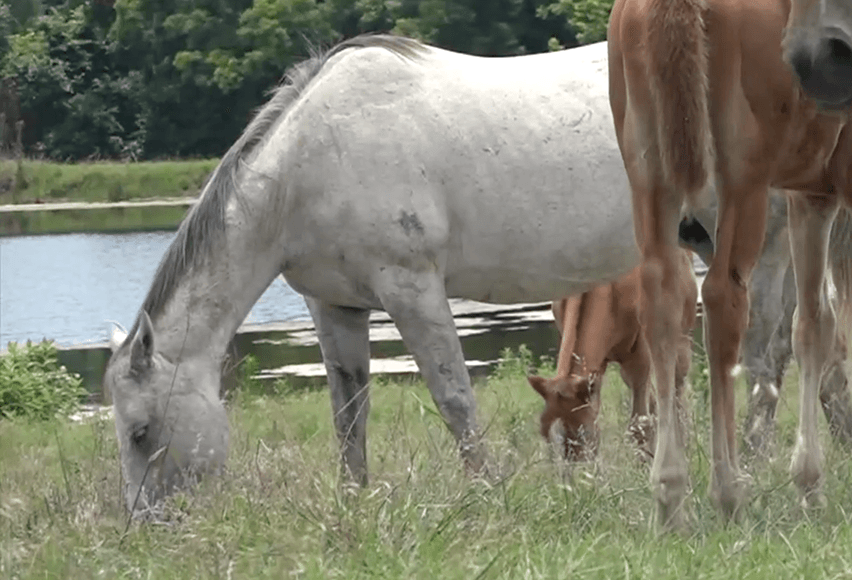Nutrition is the cornerstone of any healthy, thriving horse. The best feed for your horse optimizes its natural digestive system to get the most nutrients to match its current needs. As horses mature they have changing nutritional requirements throughout their lives. What impacts a horse’s dietary requirements? The amount of work, age, weight, gender, stress level and pregnancy status all affect the caloric requirements for horses.
Jump to Key Section
Understanding the Digestive System of HorsesThe digestive system of a horse includes the foregut and hindgut. The foregut contains enzymes to break down starches, proteins and fats. Both the small intestine and stomach are in this portion of the digestive tract. The hindgut is where microbes break up fiber from the roughage the animal consumes. Included in the hindgut are the remaining organs used for digestion — cecum, large and small colons and the rectum. How Long Does It Take for a Horse to Digest Food?These animals require 45 to 72 hours for feed to pass entirely through their digestive system. The types of horse feed and the animal’s health may affect the time it takes for digestion. What Is a Typical Diet for an Adult Horse?A horse’s usual diet depends on five types of nutrients, including ample amounts of water, starches from grains, fiber from hay, vitamins and minerals. The bulk of the animal’s diet comes from carbohydrates, with fats and proteins also contributing energy. Fats provide fuel, but limit them to no more than 10% of the intake. Proteins help build muscle, hair, skin and hooves. Tips for Improving Horse NutritionFeeding your animal well requires a balance of nutrients, energy and water. Here are some helpful tips for feeding horses that will boost nutrition and health. 1. Provide Ample Clean, Fresh WaterWater is vital to the well-being of all creatures. ON average a horse can drink 10 gallons daily, but this amount can double in hot weather or when the animal exerts itself. Always provide plenty of clean water, even in cold weather. Keep in mind that you may need a heater to prevent water from freezing in the winter. 2. Keep Grains at a MinimumThe arrangement of the digestive system illustrates how much horses need balance in their feed. Too much grain promotes gas in the hindgut because the starches in the grains break down in the foregut. Once they pass through the hindgut, the microbes there take in the remainder of the carbohydrates and produce gas as a byproduct. Excessive levels of gas can lead to discomfort and even colic. To avoid this situation, feed your horse a balance of grains and fibrous hay to promote motility and prevent gas in the hindgut. 3. Boost Forage IntakeFiber from grass or hay should equal between 1 and 2.5% of a horse’s weight. This high amount of fiber helps the animal’s digestive system operate at its best. For a 1,000-pound horse, this translates to approximately 20 pounds of hay daily, with added grains based on the amount of exertion the animal experiences, in addition to body condition. Animals that do not work may consume up to 25 pounds of hay each day with no supplemental grains (as always, consult with your veterinarian for advice on adjusting your horse’s intake). There is a relatively straightforward formula for how to estimate a horse’s body weight without a scale, based on heart girth and body length measurements. 4. Match Types of Feed to ExerciseExercise will dictate the additional amount of grain or concentrated feed your horse needs. If your horse does not work, it may not require the additional calories provided by grain. For light work, up to two hours a day, your horse may benefit from an extra one to one and a half pounds of grain per hour of effort. For two to four hours of work, some experts recommend allotting up to two pounds of supplemental grain or concentrate per hour of work. Heavy working horses that do more than four hours of work may require significantly higher levels of concentrated feed or grain to help achieve the animal’s caloric needs. 5. Know What the Body Condition Score Is for Your HorseWhile your horse’s weight is essential for knowing how much to feed it, the body condition score is also critical. What is the body condition score, and why is it important? This measurement looks at the amount of fat under the skin at specific locations on the animal’s body. You can learn to measure your horse’s body condition score yourself through classes that walk you through the process. The average ideal body condition score is five, but the best value for your horse will depend on its breed and what it does. Talk to your vet if you need advice about your animal’s body condition. 6. Don’t Make Abrupt ChangesHorses digest food over two to three days, which means changes in the feed may not cause problems immediately. If you must change your animal’s feed, do so slowly to avoid digestive troubles and upset. Inside the animal’s hindgut are bacteria that help it digest the feed it usually consumes. Specific bacteria help break down certain things. Suddenly changing feed means the gut bacteria will not be able to properly digest the animal’s new diet and the microbial balance will be thrown off. Change the feed by no more than 25% every other day to avoid digestive problems. Doing so gives your horse a week for its digestive system to acclimate to the new diet. 7. Account for Life ChangesNot all horses eat the same amount or mixture. Be ready to make changes throughout the animal’s life to mirror its changing nutritional needs. For example, there are different dietary recommendations for horses in the first years of their lives than for seniors. Pregnant and lactating mares also need specific diets to meet their needs. Exercise also changes the amount of energy your horse needs. Make changes to allow for extra nutrition when your animal does more exercise. When it works less, it will need less feed. Adjusting feed levels to match the work levels keeps your animal at a healthy weight while giving it the energy it needs for its work. 8. Help the Horse Through Stressful TimesEvery horse experiences stress at times during its life. Sudden changes in exercise, travel, too much time in the stall, pregnancy and other life events can result in stress. Horses under stress can develop ulcers or have other digestive problems. During such times, you can supplement your horse’s feed to reduce the chances of developing ulcers and help the animal use nutrition from its diet more efficiently. Such dietary amendments can help your horse wade through stressful times without severe consequences. 9. Supplement With VitaminsWhen feeding hay to horses, you likely won’t know the exact nutrient makeup of the feed. Wet and older hay may have fewer vitamins than fresh hay. To keep your animal from developing vitamin deficiencies, supplement its diet by adding vitamins and minerals to its feed. Talk to your equine vet about specific vitamin supplements to use to ensure your animal gets the nutrients it needs based on its dietary requirements and the available vitamins in the area’s pastures. 10. Watch out for Mineral RatiosLike vitamins, minerals make up a minute amount of the animal’s diet, but they provide critical roles in the functioning of the animal’s internal systems. Your horse will naturally regulate the amount of salt it takes in based on what it needs. However, you’ll need to ensure your animal gets calcium and phosphorus in the right proportions. At the very least, provide your animal with an even one-to-one ratio of calcium to phosphorus. A better balance, though, is two-to-one calcium to phosphorus to ensure your horse makes the most of these valuable minerals. Having too much calcium in the diet reduces the amount of phosphorus your horse can use. Feed Considerations for Pregnant MaresPregnant mares have unique nutritional needs in addition to dietary requirements to support their growing fetus. Nutritional recommendations for mares carrying fetuses include both energy for the mother and enough to support an expected growth curve of the fetus. 1. When to Change a Pregnant Mare’s DietMajor changes in the mare’s diet will likely not occur until the fifth month. How the diet changes depends on the time of year and the mare’s condition. 2. How Does a Pregnant Mare’s Diet Change?The amount you feed your mare during its pregnancy will change during each trimester. While during the first two trimesters, your broodmare will need enough food to support her body weight, by the third, she will need 30% more feed than she had before carrying her fetus. Mares will require even more feed if the third trimester falls during colder months when she does not have access to pasture and needs fuel to stay warm while the fetus rapidly reaches its peak size. A body condition score of six for broodmares before winter allows them enough body fat to stay warm through the winter and draw energy from if needed. For specific needs based on your mare’s weight and expected weight gain at a time during its pregnancy, the National Academies offers an interactive means of calculating intake. How Does a Horse’s Age Impact Their Nutritional Requirements?Among the things that impact a horse’s diet is age. Young, growing weanlings and yearlings have higher and different nutrient needs than mature animals. Older animals will have dietary requirements that help support any age-related health conditions they developed. FoalsFoals, especially, need an appropriate balance of calcium to phosphorus to ensure adequate bone and teeth development. Ratios may range from three-to-one to one-to-one. Talk to your vet about their recommendations for your young foal’s mineral needs. Amino acids are also crucial to growing foals. These substances build protein in the body. Overall, these young animals need 14% to 16% of their diet from protein, which is more than adults. The only specific amino acid intake requirements for yearlings and weanlings is lysine. The former group needs 2.1 g/Mcal/day, while the latter group needs slightly less at 1.9 g/Mcal/day. Pay attention to the yearling’s and weanling’s feed during the first two years. The animal will grow rapidly, reaching 86% of its adult weight by age 2. During the first year, feed yearlings an even 50-50 mixture of concentrate and hay. After age 2, switch your horse to an adult diet of hay and supplemental concentrate or grain, based on activity level. AdultsFor adult horses, allow ready access to forage and up to 25 pounds of hay daily with added grain or concentrate as a supplement. Changes in adult diets depend on whether the animal works more or is in the breeding season. SeniorsSenior horses may be hard keepers due to illnesses or difficulty chewing due to poor dental health. You will need to focus carefully on feeding them to prevent weight loss that could compromise their health. Older horses engage in less activity, but due to changes in digestion ability, they require higher protein levels, 12% to 14%, to ensure adequate absorption. Dental health and existing health problems will affect how much your senior horse eats. Fats are also necessary to help hard keepers maintain body condition. If your horse has any conditions that require special nutritional needs, talk to your vet about a customized diet. Offer multiple small meals throughout the day to your older horse. A rule of thumb is to limit feed to five pounds at each meal, and isolate older animals, so younger ones do not chase them off. Select easily digestible and chewed feed designed for older animals, and consider supplementing it with an aid that promotes proper pH of digestive enzymes. Mares vs. StallionsMares and stallions will have different nutritional needs during the breeding season. Females will require feeding based on the needs of broodmares while carrying a fetus. Stallions will also need extra energy, but not as much as you might think. For feeding a stallion, make sure to maintain the animal’s condition, regardless of the season. During non-breeding times, the stallion can meet his energy requirements by eating forage and hay. The animal will need more energy during the breeding season, as well as possible mineral and vitamin supplementation to ensure fertility. In the breeding season, a stallion increases his energy requirements by 20%, but only eats 10% more feed. To ensure the animal has enough to keep up his energy requirements, supplement his feed with concentrates. Give the horse vitamins A and E, because the stallion will need 50% more of these vitamins when breeding. Consider adding selenium and manganese to the animal’s diet if he is deficient in these, which could drop fertility. Maintaining your breeding horses during the season can ensure success and a future of foals. Supplement Your Horse’s Feed With Zesterra®When you want to care for your animal’s health and nutrition, supplement its diet with a product that encourages water intake, raises pH and promotes the proliferation of healthy bacteria in the hindgut. To support the nutrient requirements for your horses at all stages of life, consider supplementation with Zesterra®. Zesterra® helps your animal through stressful times. It also promotes natural healing of conditions such as ulcers. With an all-natural blend of ingredients, this product gives your horse’s digestive system the boost it needs to extract as many nutrients from food as possible, making it an ideal supplement for older animals or those that experience stress. To get answers to any questions you have about our products, including Zesterra®, contact us online. Related PostsHow to Choose the Right Horse for Your Riding Style The Mare: Pregnancy Trimesters 1 – 3 The Mare: Pre-Breeding Considerations Five Ways to Prepare Your Horse for Summer Sources:
|





